The Art of Reasoning a La Carte David Kelley
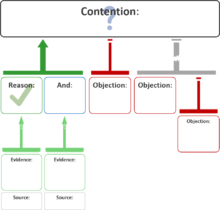
A schematic argument map showing a contention (or conclusion), supporting arguments and objections, and an inference objection.
An statement map or argument diagram is a visual representation of the structure of an statement. An argument map typically includes the key components of the statement, traditionally called the conclusion and the premises, also called contention and reasons.[1] Statement maps can also show co-bounds, objections, counterarguments, rebuttals, and lemmas. There are dissimilar styles of argument map but they are ofttimes functionally equivalent and correspond an statement's individual claims and the relationships between them.
Argument maps are ordinarily used in the context of teaching and applying critical thinking.[2] The purpose of mapping is to uncover the logical structure of arguments, place unstated assumptions, evaluate the back up an argument offers for a conclusion, and aid understanding of debates. Argument maps are oftentimes designed to support deliberation of issues, ideas and arguments in wicked problems.[3]
An argument map is not to be confused with a concept map or a mind map, ii other kinds of node–link diagram which accept dissimilar constraints on nodes and links.[four]
Primal features [edit]
A number of unlike kinds of argument maps have been proposed but the most mutual, which Chris Reed and Glenn Rowe called the standard diagram,[5] consists of a tree structure with each of the reasons leading to the decision. In that location is no consensus as to whether the conclusion should be at the top of the tree with the reasons leading up to it or whether it should be at the bottom with the reasons leading down to it.[5] Some other variation diagrams an argument from left to right.[6]
According to Douglas North. Walton and colleagues, an argument map has ii basic components: "One component is a prepare of circled numbers arrayed as points. Each number represents a proposition (premise or conclusion) in the statement being diagrammed. The other component is a set of lines or arrows joining the points. Each line (pointer) represents an inference. The whole network of points and lines represents a kind of overview of the reasoning in the given argument..."[seven] With the introduction of software for producing argument maps, it has get common for argument maps to consist of boxes containing the actual propositions rather than numbers referencing those propositions.
There is disagreement on the terminology to be used when describing statement maps,[eight] but the standard diagram contains the post-obit structures:
Dependent premises or co-premises, where at least one of the joined premises requires another premise before it can requite support to the conclusion: An argument with this structure has been called a linked argument.[9]
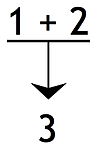
Statements one and 2 are dependent bounds or co-premises
Contained premises, where the premise can support the decision on its own: Although contained bounds may jointly make the conclusion more than disarming, this is to exist distinguished from situations where a premise gives no support unless information technology is joined to some other premise. Where several premises or groups of premises lead to a final decision the statement might be described every bit convergent. This is distinguished from a divergent argument where a single premise might be used to support two separate conclusions.[10]
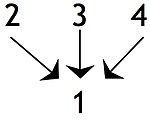
Statements 2, 3, four are independent premises
Intermediate conclusions or sub-conclusions, where a claim is supported by another merits that is used in turn to support some further merits, i.e. the final determination or some other intermediate decision: In the post-obit diagram, statement four is an intermediate decision in that information technology is a conclusion in relation to argument 5 merely is a premise in relation to the final decision, i.e. statement ane. An argument with this structure is sometimes called a circuitous argument. If there is a single chain of claims containing at least one intermediate conclusion, the argument is sometimes described equally a serial argument or a chain argument.[11]
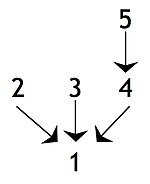
Statement four is an intermediate conclusion or sub-conclusion
Each of these structures tin be represented by the equivalent "box and line" approach to statement maps. In the following diagram, the contention is shown at the top, and the boxes linked to information technology represent supporting reasons, which comprise one or more premises. The greenish arrow indicates that the two reasons back up the contention:
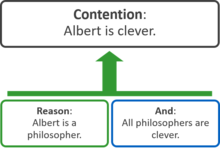
Argument maps can also represent counterarguments. In the following diagram, the two objections weaken the contention, while the reasons support the premise of the objection:
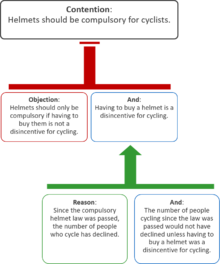
A sample argument using objections
Representing an argument as an argument map [edit]
Diagramming written text [edit]
A written text tin be transformed into an argument map by following a sequence of steps. Monroe Beardsley'south 1950 book Practical Logic recommended the post-obit procedure:[12]
- Carve up statements by brackets and number them.
- Put circles effectually the logical indicators.
- Supply, in parenthesis, whatever logical indicators that are left out.
- Prepare out the statements in a diagram in which arrows prove the relationships between statements.
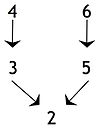
A diagram of the example from Beardsley'due south Practical Logic
Beardsley gave the starting time example of a text being analysed in this way:
- Though ① [people who talk about the "social significance" of the arts don't similar to admit it], ② [music and painting are bound to endure when they are turned into mere vehicles for propaganda]. For ③ [propaganda appeals to the crudest and nearly vulgar feelings]: (for) ④ [look at the academic monstrosities produced by the official Nazi painters]. What is more important, ⑤ [art must be an stop in itself for the creative person], because ⑥ [the creative person can do the best work just in an temper of consummate freedom].
Beardsley said that the conclusion in this instance is statement ②. Statement ④ needs to be rewritten as a declarative judgement, e.grand. "Bookish monstrosities [were] produced by the official Nazi painters." Statement ① points out that the decision isn't accustomed by everyone, but statement ① is omitted from the diagram considering it doesn't support the conclusion. Beardsley said that the logical relation betwixt statement ③ and statement ④ is unclear, but he proposed to diagram argument ④ equally supporting statement ③.
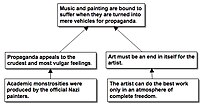
A box and line diagram of Beardsley's instance, produced using Harrell's process
More recently, philosophy professor Maralee Harrell recommended the post-obit procedure:[13]
- Identify all the claims being made by the author.
- Rewrite them as independent statements, eliminating non-essential words.
- Identify which statements are premises, sub-conclusions, and the main conclusion.
- Provide missing, implied conclusions and unsaid premises. (This is optional depending on the purpose of the argument map.)
- Put the statements into boxes and draw a line between any boxes that are linked.
- Bespeak back up from premise(southward) to (sub)conclusion with arrows.
Diagramming as thinking [edit]
Statement maps are useful not only for representing and analyzing existing writings, but also for thinking through issues every bit part of a problem-structuring process or writing process.[fourteen] The use of such argument assay for thinking through issues has been called "reflective argumentation".[15]
An argument map, dissimilar a decision tree, does not tell how to brand a decision, only the process of choosing a coherent position (or reflective equilibrium) based on the construction of an argument map can be represented every bit a decision tree.[16]
History [edit]
The philosophical origins and tradition of argument mapping [edit]
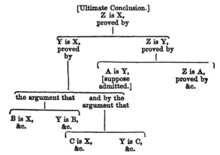
From Whately's Elements of Logic p467, 1852 edition
In the Elements of Logic, published in 1826 and issued in many subsequent editions,[17] Archbishop Richard Whately gave probably the kickoff form of an statement map, introducing it with the suggestion that "many students probably volition detect it a very clear and convenient mode of exhibiting the logical analysis of the grade of argument, to draw information technology out in the form of a Tree, or Logical Division".
Nonetheless, the technique did non get widely used, possibly because for complex arguments, it involved much writing and rewriting of the premises.
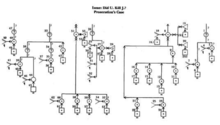
Wigmore evidence nautical chart, from 1905
Legal philosopher and theorist John Henry Wigmore produced maps of legal arguments using numbered bounds in the early 20th century,[18] based in part on the ideas of 19th century philosopher Henry Sidgwick who used lines to indicate relations betwixt terms.[19]
Anglophone statement diagramming in the 20th century [edit]
Dealing with the failure of formal reduction of informal argumentation, English speaking argumentation theory developed diagrammatic approaches to informal reasoning over a period of fifty years.
Monroe Beardsley proposed a course of statement diagram in 1950.[12] His method of marking upwards an argument and representing its components with linked numbers became a standard and is yet widely used. He too introduced terminology that is still electric current describing convergent, divergent and serial arguments.

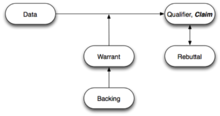
A generalised Toulmin diagram
Stephen Toulmin, in his groundbreaking and influential 1958 book The Uses of Statement,[20] identified several elements to an statement which accept been generalized. The Toulmin diagram is widely used in educational critical teaching.[21] [22] Whilst Toulmin eventually had a pregnant affect on the development of breezy logic he had little initial touch on and the Beardsley arroyo to diagramming arguments forth with its afterwards developments became the standard approach in this field. Toulmin introduced something that was missing from Beardsley's approach. In Beardsley, "arrows link reasons and conclusions (but) no support is given to the implication itself between them. There is no theory, in other words, of inference distinguished from logical deduction, the passage is always accounted not controversial and not subject field to support and evaluation".[23] Toulmin introduced the concept of warrant which "tin be considered as representing the reasons behind the inference, the backing that authorizes the link".[24]
Beardsley's approach was refined by Stephen Due north. Thomas, whose 1973 book Practical Reasoning In Tongue [25] introduced the term linked to depict arguments where the premises necessarily worked together to support the determination.[26] Still, the actual distinction between dependent and contained premises had been fabricated prior to this.[26] The introduction of the linked structure fabricated information technology possible for argument maps to represent missing or "hidden" premises. In addition, Thomas suggested showing reasons both for and against a conclusion with the reasons against being represented by dotted arrows. Thomas introduced the term statement diagram and defined basic reasons as those that were not supported past any others in the argument and the last conclusion as that which was non used to back up any further decision.

Scriven's argument diagram. The explicit premise 1 is conjoined with boosted unstated premises a and b to imply 2.
Michael Scriven further developed the Beardsley-Thomas approach in his 1976 volume Reasoning.[27] Whereas Beardsley had said "At first, write out the statements...after a little practice, refer to the statements by number alone"[28] Scriven advocated clarifying the meaning of the statements, list them and and then using a tree diagram with numbers to brandish the structure. Missing premises (unstated assumptions) were to exist included and indicated with an alphabetical letter instead of a number to mark them off from the explicit statements. Scriven introduced counterarguments in his diagrams, which Toulmin had defined every bit rebuttal.[29] This also enabled the diagramming of "balance of consideration" arguments.[30]
In 1998 a series of big-scale argument maps released by Robert E. Horn stimulated widespread interest in argument mapping.[31]
Development of reckoner-supported argument visualization [edit]
Human–computer interaction pioneer Douglas Engelbart, in a famous 1962 technical report on intelligence augmentation, envisioned in particular something similar statement-mapping software as an integral part of time to come intelligence-augmenting computer interfaces:[32]
Yous usually think of an argument as a series sequence of steps of reason, kickoff with known facts, assumptions, etc., and progressing toward a conclusion. Well, we do have to call back through these steps serially, and nosotros usually do list the steps serially when nosotros write them out because that is pretty much the mode our papers and books have to nowadays them—they are pretty limiting in the symbol structuring they enable us to utilize. ... To assist us become better comprehension of the structure of an argument, nosotros can likewise call forth a schematic or graphical brandish. Once the ancestor-consequent links have been established, the reckoner can automatically construct such a display for us.
—Douglas Engelbart, "Augmenting human intellect: a conceptual framework" (1962)
In the middle to late 1980s, hypertext software applications that supported argument visualization were developed, including NoteCards and gIBIS; the latter generated an on-screen graphical hypertextual map of an upshot-based information system, a model of argumentation developed by Werner Kunz and Horst Rittel in the 1970s.[33] In the 1990s, Tim van Gelder and colleagues developed a serial of software applications that permitted an argument map's premises to exist fully stated and edited in the diagram, rather than in a fable.[34] Van Gelder'south get-go program, Reason!Able, was superseded by two subsequent programs, bCisive and Rationale.[35]
Throughout the 1990s and 2000s, many other software applications were developed for argument visualization. By 2013, more than 60 such software systems existed.[36] In a 2010 survey of computer-supported argumentation, Oliver Scheuer and colleagues noted that one of the differences between these software systems is whether collaboration is supported.[37] In their survey, unmarried-user argumentation systems included Convince Me, iLogos, LARGO, Athena, Araucaria, and Carneades; modest group argumentation systems included Digalo, QuestMap, Compendium, Dais, and AcademicTalk; community argumentation systems included Debategraph and Collaboratorium.[37]
Applications [edit]
Argument maps have been applied in many areas, but foremost in educational, bookish and business concern settings, including design rationale.[38] Argument maps are also used in forensic science,[39] police force, and artificial intelligence.[forty] It has also been proposed that argument mapping has a neat potential to improve how we understand and execute democracy, in reference to the ongoing evolution of e-democracy.[41]
Difficulties with the philosophical tradition [edit]
It has traditionally been difficult to carve up education critical thinking from the philosophical tradition of teaching logic and method, and most critical thinking textbooks have been written by philosophers. Informal logic textbooks are replete with philosophical examples, but information technology is unclear whether the approach in such textbooks transfers to not-philosophy students.[21] There appears to be little statistical effect after such classes. Argument mapping, however, has a measurable effect according to many studies.[42] For example, instruction in statement mapping has been shown to better the disquisitional thinking skills of business students.[43]
Bear witness that statement mapping improves critical thinking power [edit]
There is empirical evidence that the skills developed in statement-mapping-based critical thinking courses substantially transfer to critical thinking washed without argument maps. Alvarez'southward meta-analysis institute that such critical thinking courses produced gains of around 0.70 SD, about twice as much as standard disquisitional-thinking courses.[44] The tests used in the reviewed studies were standard disquisitional-thinking tests.
Limitations [edit]
When used with students in school, argument maps take limitations. They can "end up looking overly circuitous" and can increase cognitive load beyond what is optimal for learning the course content.[45] Creating maps requires extensive coaching and feedback from an experienced argument mapper.[45] Depending on the learning objectives, the time spent coaching students to create good maps may be better spent learning the grade content instead of learning to diagram.[45] When the goal is to prompt students to consider other perspectives and counterarguments, the goal may exist more easily achieved with other methods such every bit discussion, rubrics, and a simple statement framework or elementary graphic organizer such as a vee diagram.[45] To maximize the strengths of statement mapping and minimize its limitations in the classroom requires considering at what point in a learning progression the potential benefits of statement mapping would outweigh its potential disadvantages.[45]
Standards [edit]
Statement Interchange Format [edit]
The Argument Interchange Format, AIF, is an international attempt to develop a representational machinery for exchanging argument resource between enquiry groups, tools, and domains using a semantically rich language.[46] AIF-RDF is the extended ontology represented in the Resource Description Framework Schema (RDFS) semantic linguistic communication. Though AIF is yet something of a moving target, it is settling down.[47]
Legal Noesis Interchange Format [edit]
The Legal Noesis Interchange Format (LKIF)[48] was developed in the European ESTRELLA project[49] and designed with the goal of condign a standard for representing and interchanging policy, legislation and cases, including their justificatory arguments, in the legal domain. LKIF builds on and uses the Web Ontology Linguistic communication (OWL) for representing concepts and includes a reusable bones ontology of legal concepts.
Argdown [edit]
Argdown is a Markdown-inspired lightweight markup language for complex argumentation.[l] It is intended for exchanging arguments and argument reconstructions in a universally accessible and highly human-readable fashion. The Argdown syntax is accompanied past tools that facilitate coding and transform Argdown documents into argument maps.[51]
See as well [edit]
- Argument engineering science
- Argumentation framework
- Argumentation scheme
- Bayesian network
- Collaborative controlling software
- Dialogue mapping
- Menses (policy debate)
- Informal fallacy
- Logic and dialectic
- Logic of argumentation
- Natural deduction – a logical organisation with statement map-like note
- Practical arguments
- Rhetorical structure theory
- Semantic tableau
- Wikidebate
Notes [edit]
- ^ Freeman 1991, pp. 49–90
- ^ For case: Davies 2012; Facione 2016, pp. 88–112; Fisher 2004; Kelley 2014, p. 73; Kunsch, Schnarr & van Tyle 2014; Walton 2013, p. 10; van Gelder 2015
- ^ For example: Culmsee & Awati 2013; Hoffmann & Borenstein 2013; Metcalfe & Sastrowardoyo 2013; Ricky Ohl, "Calculator supported argument visualisation: modelling in consultative democracy around wicked problems", in Okada, Buckingham Shum & Sherborne 2014, pp. 361–380
- ^ For example: Davies 2010; Hunter 2008; Okada, Buckingham Shum & Sherborne 2014, pp. seven–x, 4
- ^ a b Reed & Rowe 2007, p. 64
- ^ For case: Walton 2013, pp. 18–xx
- ^ Reed, Walton & Macagno 2007, p. 2
- ^ Freeman 1991, pp. 49–xc; Reed & Rowe 2007
- ^ Harrell 2010, p. 19
- ^ Freeman 1991, pp. 91–110; Harrell 2010, p. xx
- ^ Beardsley 1950, pp. 18–nineteen; Reed, Walton & Macagno 2007, pp. 3–viii; Harrell 2010, pp. 19–21
- ^ a b Beardsley 1950
- ^ Harrell 2010, p. 28
- ^ This is related to the stardom between "knowledge telling" and "noesis transforming" in composition studies: run across, for example, Chryssafidou 2014, pp. 38–39, 413
- ^ For example: Hoffmann & Borenstein 2013; Hoffmann 2016; Hoffmann 2018
- ^ See section four.2, "Argument maps as reasoning tools", in Brun & Betz 2016
- ^ Whately 1834 (commencement published 1826)
- ^ Wigmore 1913
- ^ Goodwin 2000
- ^ Toulmin 2003 (get-go published 1958)
- ^ a b Simon, Erduran & Osborne 2006
- ^ Böttcher & Meisert 2011; Macagno & Konstantinidou 2013
- ^ Reed, Walton & Macagno 2007, p. eight
- ^ Reed, Walton & Macagno 2007, p. 9
- ^ Thomas 1997 (showtime published 1973)
- ^ a b Snoeck Henkemans 2000, p. 453
- ^ Scriven 1976
- ^ Beardsley 1950, p. 21
- ^ Reed, Walton & Macagno 2007, pp. ten–11
- ^ van Eemeren et al. 1996, p. 175
- ^ Holmes 1999; Horn 1998; Robert E. Horn, "Infrastructure for navigating interdisciplinary debates: critical decisions for representing argumentation", in Kirschner, Buckingham Shum & Carr 2003, pp. 165–184
- ^ Engelbart 1962; For an business relationship of Engelbart'due south identify in the history of figurer-supported argument visualization, see, e.yard., Simon Buckingham Shum, "The roots of computer supported argument visualization", in Kirschner, Buckingham Shum & Carr 2003, pp. 3–24
- ^ Conklin & Begeman 1988, on gIBIS; Halasz 1988, on NoteCards; Kirschner, Buckingham Shum & Carr 2003, pp. 14–15, on the place of both in the history of computer-supported argument visualization
- ^ van Gelder 2007
- ^ Berg et al. 2009
- ^ Walton 2013, p. 11
- ^ a b Scheuer et al. 2010
- ^ Kirschner, Buckingham Shum & Carr 2003; Okada, Buckingham Shum & Sherborne 2014
- ^ For example: Bex 2011
- ^ For case: Verheij 2005; Reed, Walton & Macagno 2007; Walton 2013
- ^ Hilbert 2009
- ^ Twardy 2004; Álvarez Ortiz 2007; Harrell 2008; Yanna Rider and Neil Thomason, "Cognitive and pedagogical benefits of argument mapping: LAMP guides the fashion to better thinking", in Okada, Buckingham Shum & Sherborne 2014, pp. 113–134; Dwyer 2011; Davies 2012
- ^ Carrington et al. 2011; Kunsch, Schnarr & van Tyle 2014
- ^ Álvarez Ortiz 2007, pp. 69–70 et seq
- ^ a b c d e Nussbaum 2012, pp. 125, 133
- ^ Encounter the AIF original typhoon description (2006) and the full AIF-RDF ontology specifications in RDFS format.
- ^ Bex et al. 2013
- ^ Boer, Winkels & Vitali 2008
- ^ "Estrella project website". estrellaproject.org. Archived from the original on 2016-02-12. Retrieved 2016-02-24 .
- ^ Meet Voigt 2014. The Argdown website is argdown.org. Argdown is currently developed equally an open up source project: "christianvoigt/argdown: a simple syntax for complex argumentation". GitHub.com . Retrieved 2019-x-xxx .
- ^ Argdown tools include a spider web browser sandbox editor, an extension for Visual Studio Code, and a control-line tool; meet "Getting started". argdown.org . Retrieved 2019-10-30 .
References [edit]
- Álvarez Ortiz, Claudia María (2007). Does philosophy ameliorate critical thinking skills? (PDF) (M.A. thesis). Department of Philosophy, University of Melbourne. OCLC 271475715. Archived from the original (PDF) on 2012-07-08.
- Beardsley, Monroe C. (1950). Practical logic. New York: Prentice-Hall. OCLC 4318971. A shorter version was published as Thinking Directly; the most contempo edition is: Beardsley, Monroe C. (1975). Thinking directly: principles of reasoning for readers and writers (4th ed.). Englewood Cliffs, NJ: Prentice-Hall. ISBN978-0139182358. OCLC 1168973.
- Berg, Timo ter; van Gelder, Tim; Patterson, Fiona; Teppema, Sytske (2009). Critical thinking: reasoning and communicating with Rationale. Amsterdam: Pearson Education Benelux. ISBN978-9043018012. OCLC 301884530.
- Bex, Floris J. (2011). Arguments, stories and criminal evidence: a formal hybrid theory. Constabulary and philosophy library. Vol. 92. Dordrecht; New York: Springer. doi:ten.1007/978-94-007-0140-3. ISBN9789400701397. OCLC 663950184.
- Bex, Floris J.; Modgil, Sanjay; Prakken, Henry; Reed, Chris (2013). "On logical specifications of the Statement Interchange Format" (PDF). Journal of Logic and Computation. 23 (5): 951–989. doi:10.1093/logcom/exs033.
- Boer, Alexander; Winkels, Radboud; Vitali, Fabio (2008). "MetaLex XML and the Legal Noesis Interchange Format". In Casanovas, Pompeu; Sartor, Giovanni; Casellas, Núria; Rubino, Rossella (eds.). Computable models of the police force: languages, dialogues, games, ontologies. Lecture Notes in Computer science. Vol. 4884. Berlin; New York: Springer. pp. 21–41. doi:x.1007/978-three-540-85569-9_2. ISBN9783540855682. OCLC 244765580. Retrieved 2016-02-24 .
- Böttcher, Florian; Meisert, Anke (February 2011). "Argumentation in science didactics: a model-based framework". Science & Education. twenty (2): 103–140. Bibcode:2011Sc&Ed..20..103B. doi:10.1007/s11191-010-9304-5. S2CID 119954511.
- Brun, Georg; Betz, Gregor (2016). "Analysing practical argumentation" (PDF). In Hansson, Sven Ove; Hirsch Hadorn, Gertrude (eds.). The argumentative turn in policy analysis: reasoning about dubiety. Logic, argumentation & reasoning. Vol. x. Cham; New York: Springer-Verlag. pp. 39–77. doi:x.1007/978-three-319-30549-3_3. ISBN9783319305479. OCLC 950884495.
- Carrington, Michal; Chen, Richard; Davies, Martin; Kaur, Jagjit; Neville, Benjamin (June 2011). "The effectiveness of a unmarried intervention of computer‐aided statement mapping in a marketing and a financial accounting subject". Higher Education Inquiry & Development. 30 (3): 387–403. doi:ten.1080/07294360.2011.559197. S2CID 144862766. Retrieved 2016-02-24 .
- Chryssafidou, Evangelia (May 2014). Argument diagramming and planning noesis in argumentative writing (Ph.D. thesis). Birmingham, United kingdom: University of Birmingham. OCLC 890146780.
- Conklin, Eastward. Jeffrey; Begeman, Michael L. (Oct 1988). "gIBIS: a hypertext tool for exploratory policy discussion". ACM Transactions on Data Systems. 6 (4): 303–331. doi:10.1145/58566.59297. S2CID 2609461.
- Culmsee, Paul; Awati, Kailash (2013) [2011]. "Affiliate 7: Visualising reasoning, and Chapter viii: Argumentation-based rationale". The heretic's guide to best practices: the reality of managing complex issues in organisations. Bloomington, IN: iUniverse, Inc. pp. 153–211. ISBN9781462058549. OCLC 767703320.
- Davies, W. Martin (November 2010). "Concept mapping, mind mapping and argument mapping: what are the differences and exercise they matter?". Higher Education. 62 (three): 279–301. doi:ten.1007/s10734-010-9387-half-dozen. S2CID 44953977.
- Davies, W. Martin (Summer 2012). "Computer-aided argument mapping equally a tool for instruction critical thinking". International Journal of Learning and Media. 4 (three–4): 79–84. doi:ten.1162/IJLM_a_00106.
- Dwyer, Christopher Peter (2011). The evaluation of argument mapping as a learning tool (PDF) (Ph.D. thesis). School of Psychology, National University of Ireland, Galway. OCLC 812818648. Retrieved 2016-02-24 .
- van Eemeren, Frans H.; Grootendorst, Rob; Snoeck Henkemans, A. Francisca; Blair, J. Anthony; Johnson, Ralph H.; Krabbe, Erik C. W.; Plantin, Christian; Walton, Douglas Due north.; Willard, Charles A.; Woods, John (1996). Fundamentals of argumentation theory: a handbook of historical backgrounds and gimmicky developments . Mahwah, NJ: Lawrence Erlbaum Associates. doi:10.4324/9780203811306. ISBN978-0805818611. OCLC 33970847.
- Engelbart, Douglas C. (1962). Augmenting human intellect: a conceptual framework. Menlo Park, CA: Stanford Research Constitute. OCLC 8671016. Archived from the original on 2011-05-04. Retrieved 2018-04-09 .
- Facione, Peter A. (2016) [2011]. Retrieve critically (3rd ed.). Boston: Pearson. ISBN978-0133909661. OCLC 893099404.
- Fisher, Alec (2004) [1988]. The logic of real arguments (2d ed.). Cambridge; New York: Cambridge University Printing. doi:x.1017/CBO9780511818455. ISBN978-0521654814. OCLC 54400059. Retrieved 2016-02-24 .
- Freeman, James B. (1991). Dialectics and the macrostructure of arguments: a theory of argument construction. Berlin; New York: Foris Publications. ISBN978-3110133905. OCLC 24429943. Retrieved 2016-02-24 .
- van Gelder, Tim (2007). "The rationale for Rationale" (PDF). Constabulary, Probability and Chance. vi (1–4): 23–42. doi:ten.1093/lpr/mgm032.
- van Gelder, Tim (2015). "Using argument mapping to improve critical thinking skills". In Davies, Martin; Barnett, Ronald (eds.). The Palgrave handbook of disquisitional thinking in higher education. New York: Palgrave Macmillan. pp. 183–192. doi:10.1057/9781137378057_12. ISBN9781137378033. OCLC 894935460.
- Goodwin, Jean (2000). "Wigmore's chart method". Informal Logic. 20 (3): 223–243. doi:x.22329/il.v20i3.2278.
- Halasz, Frank G. (July 1988). "Reflections on NoteCards: seven issues for the side by side generation of hypermedia systems". Communications of the ACM. 31 (seven): 836–852. CiteSeerX10.ane.1.124.2308. doi:10.1145/48511.48514.
- Harrell, Maralee (December 2008). "No calculator plan required: even pencil-and-newspaper argument mapping improves critical-thinking skills" (PDF). Teaching Philosophy. 31 (iv): 351–374. doi:10.5840/teachphil200831437. Archived from the original (PDF) on 2013-12-29.
- Harrell, Maralee (August 2010). "Creating argument diagrams". academia.edu.
- Hilbert, Martin (April 2009). "The maturing concept of e-commonwealth: from eastward-voting and online consultations to democratic value out of jumbled online chatter" (PDF). Journal of Information technology and Politics. 6 (2): 87–110. doi:10.1080/19331680802715242. S2CID 15790311.
- Hoffmann, Michael H. One thousand. (November 2016). "Cogitating argumentation: a cognitive function of arguing". Argumentation. thirty (4): 365–397. doi:x.1007/s10503-015-9388-9. S2CID 146779158.
- Hoffmann, Michael H. G. (March 2018). "Stimulating reflection and self-correcting reasoning through argument mapping: three approaches". Topoi. 37 (one): 185–199. doi:10.1007/s11245-016-9408-ten. S2CID 123754143.
- Hoffmann, Michael H. K.; Borenstein, Jason (Feb 2013). "Understanding sick-structured technology ethics bug through a collaborative learning and statement visualization approach". Science and Engineering Ethics. xx (ane): 261–276. doi:10.1007/s11948-013-9430-y. PMID 23420467. S2CID 14247458.
- Holmes, Bob (10 July 1999). "Beyond words". New Scientist. No. 2194. Archived from the original on 28 September 2008.
- Horn, Robert E. (1998). Visual linguistic communication: global communication for the 21st century. Bainbridge Isle, WA: MacroVU, Inc. ISBN978-1892637093. OCLC 41138655.
- Hunter, Lawrie (2008). "Cmap linking phrase constraint for the structural narrowing of constructivist 2d language tasks" (PDF). In Cañas, Alberto J.; Reiska, Priit; Åhlberg, Mauri Thou.; Novak, Joseph Donald (eds.). CMC 2008: Third International Briefing on Concept Mapping, Tallinn, Estonia and Helsinki, Finland, 22–25 September 2008: proceedings. Vol. 1. Tallinn: Tallinn Academy. pp. 146–151. ISBN9789985585849.
- Kelley, David (2014) [1988]. The art of reasoning: an introduction to logic and disquisitional thinking (4th ed.). New York: W. W. Norton & Company. ISBN978-0393930788. OCLC 849801096.
- Kirschner, Paul Arthur; Buckingham Shum, Simon J; Carr, Republic of chad S, eds. (2003). Visualizing argumentation: software tools for collaborative and educational sense-making. Reckoner supported cooperative work. New York: Springer. doi:10.1007/978-ane-4471-0037-ix. ISBN978-1852336646. OCLC 50676911. S2CID 46267938. Retrieved 2016-02-24 .
- Kunsch, David W.; Schnarr, Karin; van Tyle, Russell (November 2014). "The use of argument mapping to enhance critical thinking skills in business instruction". Journal of Instruction for Business. 89 (8): 403–410. doi:10.1080/08832323.2014.925416. S2CID 38666976.
- Macagno, Fabrizio; Konstantinidou, Aikaterini (August 2013). "What students' arguments can tell us: using argumentation schemes in science didactics". Argumentation. 27 (iii): 225–243. doi:ten.1007/s10503-012-9284-five. S2CID 189942834. SSRN 2185945.
- Metcalfe, Mike; Sastrowardoyo, Saras (November 2013). "Complex project conceptualisation and argument mapping". International Journal of Project Direction. 31 (8): 1129–1138. doi:x.1016/j.ijproman.2013.01.004.
- Nussbaum, E. Michael (2012). "Argumentation and student-centered learning environments". In Jonassen, David H.; Land, Susan Chiliad. (eds.). Theoretical foundations of learning environments (2nd ed.). New York: Routledge. pp. 114–141. doi:10.4324/9780203813799. ISBN9780415894210.
- Okada, Alexandra; Buckingham Shum, Simon J; Sherborne, Tony, eds. (2014) [2008]. Cognition cartography: software tools and mapping techniques. Advanced information and cognition processing (second ed.). New York: Springer. doi:10.1007/978-1-4471-6470-8. ISBN9781447164692. OCLC 890438015. S2CID 28008938. Retrieved 2016-02-24 .
- Reed, Chris; Rowe, Glenn (2007). "A pluralist arroyo to argument diagramming" (PDF). Police, Probability and Take chances. 6 (1–iv): 59–85. doi:10.1093/lpr/mgm030 . Retrieved 2016-02-24 .
- Reed, Chris; Walton, Douglas; Macagno, Fabrizio (March 2007). "Statement diagramming in logic, constabulary and artificial intelligence". The Knowledge Engineering Review. 22 (1): 87. doi:ten.1017/S0269888907001051. S2CID 26294789.
- Scheuer, Oliver; Loll, Frank; Pinkwart, Niels; McLaren, Bruce M. (2010). "Calculator-supported argumentation: a review of the state of the art" (PDF). International Journal of Computer-Supported Collaborative Learning. 5 (1): 43–102. CiteSeerX10.i.1.322.2522. doi:ten.1007/s11412-009-9080-x. S2CID 4473082.
- Scriven, Michael (1976). Reasoning. New York: McGraw-Hill. ISBN978-0070558823. OCLC 2800373.
- Simon, Shirley; Erduran, Sibel; Osborne, Jonathan (2006). "Learning to teach argumentation: research and evolution in the scientific discipline classroom" (PDF). International Journal of Science Teaching. 28 (ii–3): 235–260. Bibcode:2006IJSEd..28..235S. doi:x.1080/09500690500336957. S2CID 145163500. Archived from the original (PDF) on 2015-09-19. Retrieved 2015-01-12 .
- Snoeck Henkemans, A. Francisca (November 2000). "State-of-the-fine art: the structure of argumentation". Argumentation. fourteen (4): 447–473. doi:10.1023/A:1007800305762. S2CID 140364997.
- Thomas, Stephen Northward. (1997) [1973]. Practical reasoning in natural language (fourth ed.). Upper Saddle River, NJ: Prentice-Hall. ISBN978-0136782698. OCLC 34745923.
- Toulmin, Stephen E. (2003) [1958]. The uses of argument (Updated ed.). Cambridge; New York: Cambridge Academy Printing. doi:10.1017/CBO9780511840005. ISBN978-0521534833. OCLC 57253830. Retrieved 2016-02-24 .
- Twardy, Charles R. (June 2004). "Argument maps improve critical thinking" (PDF). Education Philosophy. 27 (two): 95–116. doi:x.5840/teachphil200427213.
- Verheij, Bart (2005). Virtual arguments: on the design of argument administration for lawyers and other arguers. Information technology & police force series. Vol. vi. The Hague: T.M.C. Asser Press. ISBN9789067041904. OCLC 59617214.
- Voigt, Christian (2014). "Argdown and the stacked masonry layout: two user interfaces for non-expert users". In Parsons, Simon; Oren, Nir; Reed, Chris; Cerutti, Federico (eds.). Computational models of argument: proceedings of COMMA 2014. Frontiers in artificial intelligence and applications. Vol. 266. Amsterdam: IOS Press. pp. 483–484. doi:x.3233/978-1-61499-436-seven-483. ISBN9781614994367. OCLC 894508689.
- Walton, Douglas N. (2013). Methods of argumentation. Cambridge; New York: Cambridge University Press. doi:ten.1017/CBO9781139600187. ISBN978-1107677333. OCLC 830523850. Retrieved 2016-02-24 .
- Whately, Richard (1834) [1826]. Elements of logic: comprising the substance of the article in the Encyclopædia metropolitana: with additions, &c (5th ed.). London: B. Fellowes. OCLC 1739330. Retrieved 2016-02-24 .
- Wigmore, John Henry (1913). The principles of judicial proof: as given by logic, psychology, and full general experience, and illustrated in judicial trials. Boston: Little Brown. OCLC 1938596. Retrieved 2016-02-24 .
Farther reading [edit]
- Barstow, Brendan; Fazio, Lisa; Lippman, Jordan; Falakmasir, Mohammad; Schunn, Christian D.; Ashley, Kevin D. (December 2017). "The impacts of domain-general vs. domain-specific diagramming tools on writing". International Journal of Bogus Intelligence in Education. 27 (4): 671–693. doi:10.1007/s40593-016-0130-z. S2CID 5567454.
- Cahill, Ann J.; Bloch-Schulman, Stephen (March 2012). "Argumentation stride-by-step: learning critical thinking through deliberate practise" (PDF). Didactics Philosophy. 35 (1): 41–62. doi:10.5840/teachphil20123514.
- Cullen, Simon (30 August 2017). "Philosophy mapped". philmaps.com . Retrieved 1 September 2017. Free online resources for teachers and students interested in argument mapping in philosophy.
- Facione, Peter A.; Facione, Noreen C. (2007). Thinking and reasoning in human decision making: the method of argument and heuristic analysis. Milbrae, CA: California Academic Printing. ISBN978-1891557583. OCLC 182039452.
- van Gelder, Tim (17 February 2009). "What is argument mapping?". timvangelder.com. Retrieved 12 January 2015.
- Harrell, Maralee (June 2005). "Using statement diagramming software in the classroom" (PDF). Teaching Philosophy. 28 (2): 163–177. CiteSeerXten.1.ane.526.7982. doi:x.5840/teachphil200528222. Archived from the original (PDF) on 2006-09-07.
- Harrell, Maralee; Wetzel, Danielle (2015). "Using argument diagramming to teach critical thinking in a first-year writing course". In Davies, Martin; Barnett, Ronald (eds.). The Palgrave handbook of critical thinking in college educational activity. New York: Palgrave Macmillan. pp. 213–232. doi:10.1057/9781137378057_14. ISBN9781137378033. OCLC 894935460.
- Schneider, Jodi; Groza, Tudor; Passant, Alexandre (April 2013). "A review of argumentation for the social semantic web" (PDF). Semantic Spider web. 4 (ii): 159–218. doi:10.3233/SW-2012-0073.
macdonnellfruck1991.blogspot.com
Source: https://en.wikipedia.org/wiki/Argument_map